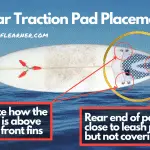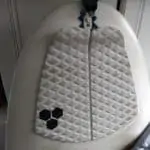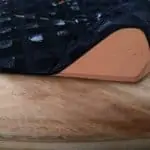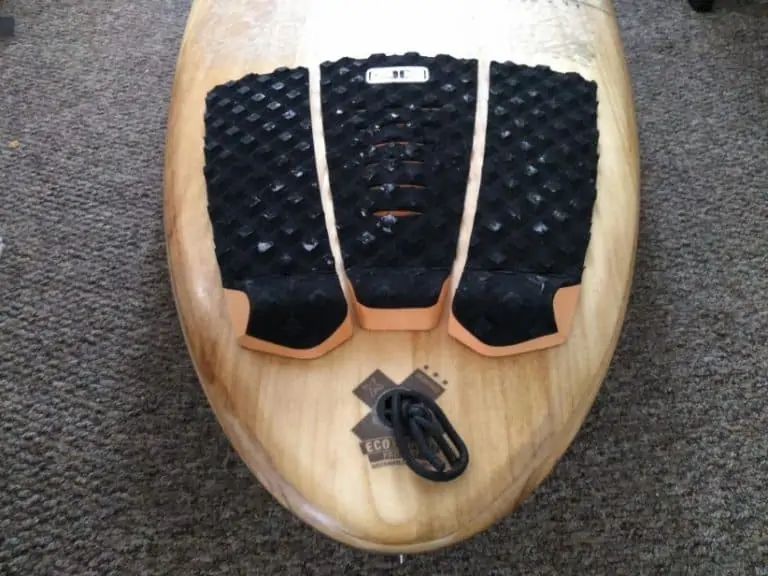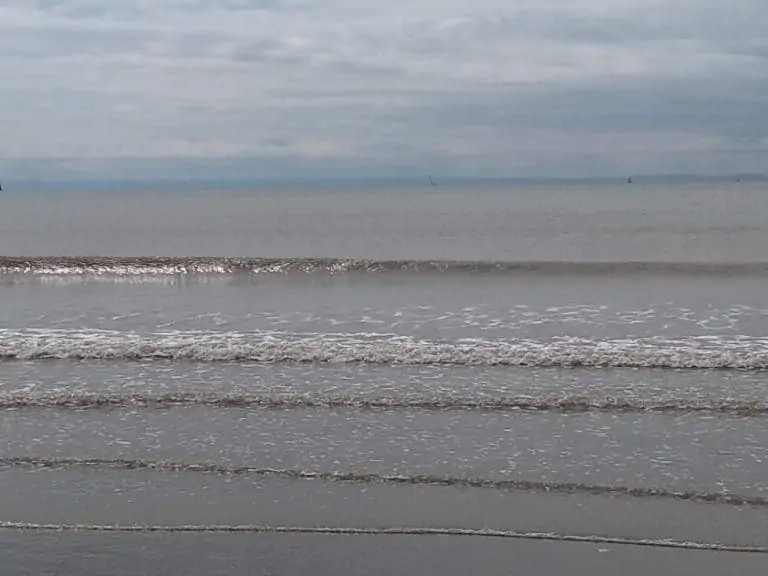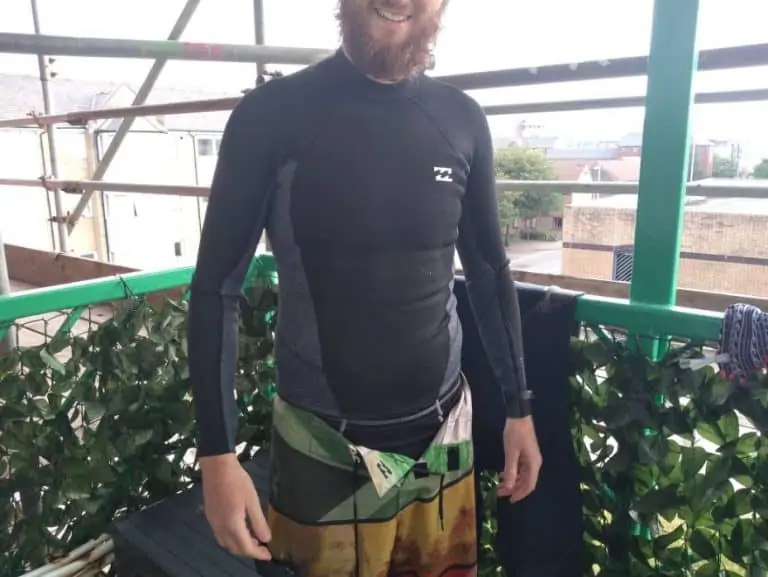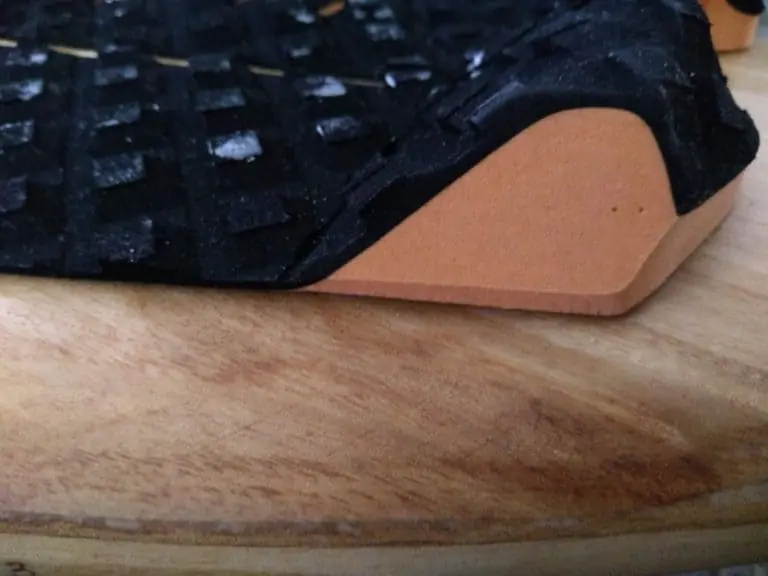Types of Surfboard That Do (and Don’t) Work With Traction Pads
Traction pads are best suited to shorter fiberglass surfboards and for those of an intermediate level and up since they help with turning. Traction pads cannot be put on soft-top learner boards since they won’t stick, so they are not ideal for complete beginners.
Now, let’s look in more detail at the types of surfboard available in the different constructions and all the thoughts you need to consider before buying a traction pad (or not).
Surfboard Constructions and Traction Pads
| Surfboard Construction | Traction Pads Work? |
| Fiberglass ‘PU’ Surfboard | Yes |
| Epoxy Surfboard | Yes |
| Soft-top Foam Surfboard | No |
Fiberglass ‘PU’ Surfboard
Traction pads are recommended for most fiberglass surfboards since they stick well and, in fact, a traction pad can also protect the surface of your surfboard from dents and dings as it covers it with a foam pad!
I really like a rear traction pad on my fiberglass surfboards, but the shape of your surfboard and your level will determine whether a traction pad is right for you, as I’ll explain in a subsequent section.
Epoxy Surfboard
Traction pads work very well with epoxy construction surfboards but whether you need one depends on the shape of the board, as explained below.
If you are not sure, google your surfboard brand and model to check the construction but know that fiberglass boards are softer and dent more easily than epoxy construction surfboards, so if your board has no dents and lots of use, it’s probably epoxy.
Soft-top Foam Surfboard
Traction pads do not stick to soft-top or soft-foam surfboards so they cannot be used with these kinds of learner surfboard. If you have one of these, simply make sure you keep waxing your board every time before you surf instead, although the rest of this article may be helpful for future reference.
If you try to fix a traction pad to a soft-foam foam surfboard, it will simply fall off because the surface is not smooth enough to make a strong and consistent bond between the adhesive on the pad and the surface of the board, meaning money lost for you.
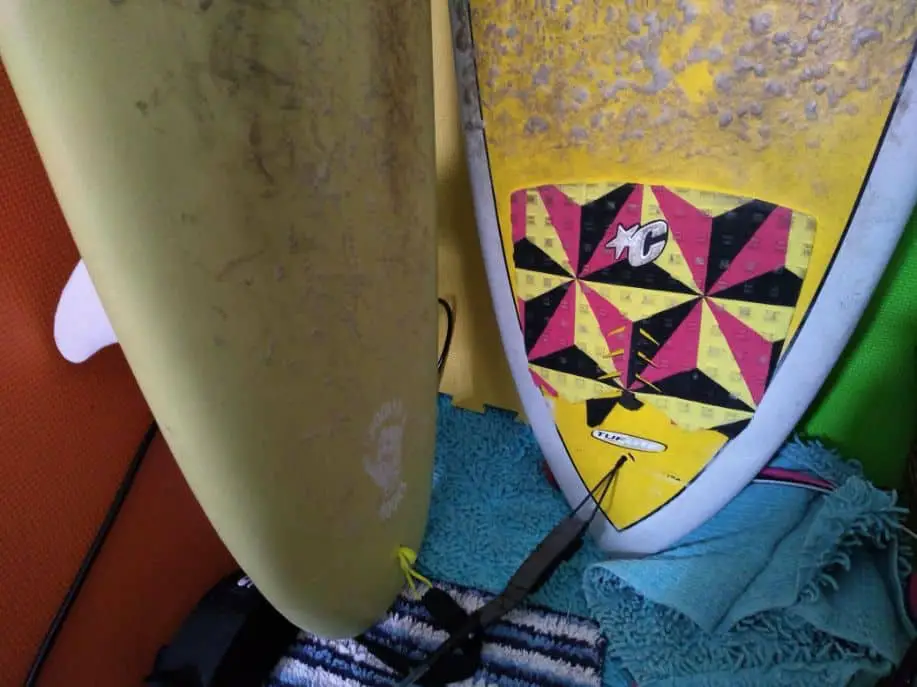
Now that you know what kinds of surfboard construction can have traction pads, let’s now look at the different types of traction pad and which ones are most commonly used on what boards.
As a quick primer, the main types of traction pads for surfboards are the following:
- Rear traction pad or ‘tail pad’: goes at the back of the board, best for turning and particularly helpful on shorter boards. Has a kick at the back to stop your foot slipping off the end of your board.
- Front traction pad: Placed in the middle of the board under your chest. Most popular in the 1980s but becoming more popular again now, especially for advanced surfers trying airs because of the extra grip under the front foot. Flat to allow you to lie down on it.
- Full deck grip traction pads: Usually 3 traction pads with rear and two flat front pads, covering about two-thirds of the surfboard from the rear up. Most common on stand-up paddleboards (SUP) although again becoming more popular with shortboard riders.
Surfboard Shape Traction Pads: Most Common Pad for Every Board
| Surfboard Shape/Template | Traction Pad Possible | Most Common Pad |
| Mini-Malibu Surfboard (i.e. most common learner board) | Yes | Rear or ‘tail’ pad |
| Longboard | Yes | Full deck grip but still uncommon |
| Fish | Yes* but some need a special rear traction pad | Rear pad |
| Funboard | Yes | Rear pad |
| Shortboard | Yes | Rear pad but full deck grip possible |
| Stand-up Paddleboard | Yes | Full deck grip |
Traction Pads are Optional for Mini-malibu Surfboards
Fiberglass or epoxy Mini-malibu or ‘Mini-mal’ surfboards work fine with traction pads but they really are optional because these boards aren’t possible to turn hard or surf aggressively, meaning that there is little benefit in having a traction pad.
That said, some riders might prefer having the soft touch of a rear traction pad under foot and one pad may be nice for certain riders.
Traction Pads are Optional for Longboards
You can use full-deck traction pads on a longboard surfboard but this is uncommon and not needed. The full-deck grip here might actually need 4-5 pads given the length of a longboard. This can help to save time waxing your longboard since there is so much surface area to wax each time.
That said, you’ll need to get the exact placement for each pad right because there are so many pieces and most full-deck traction pad sets for longboards will sit next to each other, meaning one wrong placement can throw out the whole pattern.
Rear Traction Pads Are Good for Fish Surfboards
A rear traction pad works well with a standard fish surfboard template but if you have a ‘retro’ fish with a deep swallow tail (and usually twin fins), then you will need a special tail pad for that kind of board.
Fish surfboards are great for turning and so a rear traction pad is helpful here. Personally, I would not recommend a full-deck grip set for a fish because they don’t really suit doing airs, although some may disagree.
If you have a retro fish surfboard, get only a tail pad that says it is for your specific board and nothing else. You should be able to see this from the image and these are available from Amazon.
Rear Traction Pads Are Best for Funboards
You can use a rear traction pad with a funboard surfboard if you like but it really is optional because you won’t get much benefit out of it, again because you won’t be doing aggressive turns where a traction pad is helpful.
As with other intermediate boards, a traction pad on a funboard comes down to personal preference as you might find it nicer to ride with one and like waxing your surfboard less.
Traction Pads Are Great for Shortboards
Traction pads are great with shortboard surfboards and you can use both rear pads and full-deck grip, but I recommend just a rear pad for most people. This is because full-deck grip is really only for anyone trying airs or those who really can’t stand wax.
Otherwise, a combination of rear pad and wax on the rest of the board will be absolutely fine for 95% of shortboard riders.
Traction Pads are Helpful for Stand-up Paddleboards
A full-deck grip set of traction pads is best for stand-up paddleboards because there is so much surface area to cover and having the consistent grip underfoot makes it easier when you are up and riding.
It is also common for SUPs to come with this kind of grip, meaning that you don’t often have to buy and attach these yourself, meaning one less task for you!
As you can see, traction pads are best for specific types of surfboards and for different purposes. The main thing is not to buy a traction pad for a soft-top surfboard and only get a pad for another board if you think you need it or are looking to progress.
If you’re about to buy or just bought a traction pad, check out my guide to perfect traction pad placement to get it right first time!
Check out my other articles on traction pads here now!
